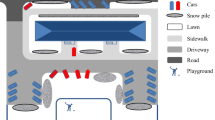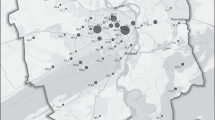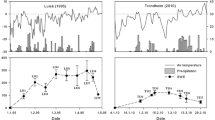Abstract
The study is aimed to assess the composition and properties of solid material supply to the environment from vehicles. The study was conducted in the area of an ice race track located on the surface of a lake located at a significant distance from the stationary sources of pollution. The sampling was conducted on February 27, 2019. The samples of snow cover and ice were collected at the roadside of the track and at a distance of > 10 m from the ice race track in the winter period. The ice race track was located on Lake Baltym (north of Ekaterinburg, Sverdlovsk region, Russia). The samples of snow were melted. The solid material of the samples was separated with filter paper and dried. The particles were selected manually and photographed using an optical microscope, and then they were analyzed with a scanning electron microscope. The origin of the selected particles was determined. The particles were classified into three types:
-
fragments of car tires (5 particles per 1 L of meltwater in the curb area of the ice race track),
-
fragments of cast-iron brake discs (2 particles per 1 L of meltwater),
-
fragments of a composite material of car brake pads.
The approximate amount of solid material supply to the lake from the ice race track during one season was estimated at the level of 40 mg/L.
Access provided by Autonomous University of Puebla. Download conference paper PDF
Similar content being viewed by others
Keywords
- Automobile transport
- Pollution
- Snow cover
- Ice
- Chemical elements
- Anthropogenic particles
- Ice race track
- Lake
1 Introduction
In recent decades, road transport has become the main source of urban pollution (Bucko et al. 2013). Road transport produces not only emissions but also mineral materials and solid particles, which are the products of corrosion and abrasion of tires, brake pads and other car parts (Pant and Harrison 2013). Heavy metals, road paint particles and mineral materials also enter the road sediments when abrading the road surface (Grant 2015; Lanzerstorfer 2018). The pollution supply from automobiles occurs all year round. In the winter season, snow cover and snow-dirt sludge on the roads accumulate pollutants from automobile traffic (Adamiec et al. 2013; Shi et al. 2014; Seleznev et al 2019).
Water and bottom sediments of the surface water bodies, which the city has in the catchment, are geochemically transformed as a result of pollution intake. Components of aquatic ecosystems are the ultimate depot for transporting pollution from non-point sources (Chen et al. 2018). The ecological state of water bodies depends on a complex of natural and anthropogenic factors when pollutants enter the water body with a material of various origins. Several authors categorize the main types of technogenic particles found in urban areas (Bucko et al. 2013; Seleznev et al. 2020). However, the great diversity of automobile materials used makes it difficult to distinguish between vehicle wear products. Friction materials of automobile brake systems are usually made from natural mineral raw materials (zircon, antimonite, aluminosilicates). Therefore, the assessment of pollution supply from vehicles in a large city is a very difficult and often impossible task.
The study was aimed to assess the composition and properties of material entering the environment during the exploitation of road transport. A special area, in which cars were the only main source of pollution, was chosen. The selected zone was characterized by the absence of material supply of natural origin, and the pollution of the study area from stationary sources was negligible. Such an area was represented by the surface of a lake, on which an ice race track was constructed in the winter period.
2 Materials and Methods
The ice race track is located on Lake Baltym (Sverdlovsk region, Russia; coordinates: 57.026608° N, 60.580374° E). The track has been functioning regularly in winters since 2008 (Fig. 1, (https://www.google.ru/maps/@57.043446,60.581969,3a,90y,3.88h,30.83t/data=!3m8!1e1!3m6!1sAF1QipNXQkxg3B5dLnB-tuH5gF64OMmnd5zgaAuapyv7!2e10!3e11!6shttps:%2F%2Flh5.googleusercontent.com%2Fp%2FAF1QipNXQkxg3B5dLnB-tuH5gF64OMmnd5zgaAuapyv7%3Dw203-h100-k-no-pi-0-ya69.65704-ro-0-fo100!7i12000!8i6000?hl=ru)). All cars undergo technical inspection and wheel washing before entering the race track. Lake Baltym is located north of Ekaterinburg, the city with the population of approximately 1.5 million people. The lake has a saucer shape, stretched from north to south. The surface area of the lake is 7.5 km2, the catchment area is 27 km2. Lake Baltym has a sufficiently large water mass of over 20∙106 m3. The average depth of the lake is 3–4 m, the max is 6.5 m. The bottom topography is relatively flat with a decrease to the center. The pitfalls are located on the east and west coast. The bottom of the lake is silt with sandy areas on the eastern side (Nikolaenko 1965).
The samples of snow and crushed ice were collected by the following scheme:
-
The samples were collected at 6 sampling sites located at the roadside of the ice race track. At one sampling site, two combined samples of snow and crushed ice were taken from the external (1) and internal (2) curbs relatively to the turn of the route. Snow was taken by a scoop; crushed ice was swept from the surface with a brush.
-
One combined sample of snow and crushed ice was collected from the surface of a circular drift track along the entire length.
-
Three sampling sites were located at the distance of > 10 m from the ice race track along the entire route. The full height of the undisturbed snow core was taken by a shovel from one site. The snow depth was < 1 m.
The volume of each sample collected at the roadside area and the circular drift track was 100 mL. The volume of the sample of the undisturbed snow core was 5 L. The coordinates of sampling sites are presented in Table 1. Examples of sampling are shown in Fig. 2.
The collected samples of snow and crushed ice were melted at room temperature. The solid material of the samples was separated with filter paper and dried. The number of solid particles > 1 mm (large) and < 1 mm (small) in size was calculated in each sample using a binocular microscope. Then single visually typical particles were selected manually and photographed using a Carl Zeiss Axioplan 2 optical microscope equipped with an Olympus C-5060 digital camera. The selected particles were analyzed using a JSM-6390LV scanning electron microscope (SEM) at the Geoanalyst Common Use Center of the Ural Branch of RAS (www.geoanalyst.igg.uran.ru). The images of particles in secondary-scattered electrons and the chemical composition of particles were obtained.
3 Results and Discussion
The sampling was conducted on February 27, 2019. Sixteen samples of snow and ice were collected. All samples from the external curbs of the track contained solid particles of various sizes, including 4–12 large particles per 100 mL of meltwater. Large particles were not found in the samples from the internal curbs of the track; those samples contained a small number of particles < 1 mm in size. The snow samples collected at the sites of undisturbed snow did not have solid particles. The particles from 10 samples were analyzed using SEM. The distribution of particles of various sizes in 10 collected samples is presented in Table 1.
The solid particles found in the analyzed samples could be divided into several types. The 1st type of particles are large particles of long cylindrical shape, black, with a matte surface, elastic, 20 × 2 × 2 mm in size. The photo from the optical microscope is shown in Fig. 3. The chemical composition of this particle is given in Table 2.
The surface of this type of particle contains small fragments of metallic Fe and Cr (Fig. 4). The chemical composition of the fragments of metallic Fe and Cr on the surface of the 1st type particle is shown in Table 3.
The 2nd type of particles is represented by large particles of irregular shape and dark gray color, 0.5 × 0.4 × 0.3 mm in size, with strong metallic luster and high hardness. Fe predominates in the composition of the 2nd type particles; Zn and Mn are partially oxidized impurities. The photo of the 2nd type of particle from SEM is shown in Fig. 5, the chemical composition is presented in Table 4.
The 3rd type particles are fine mineral particles < 15 μm in size, consisting of clay minerals, and including fragments of brass, zirconium silicate, iron sulfide, hydromica, alloys of Fe with Ti and V. The fine mineral material was found in all 10 analyzed samples. The particles of the 3rd type in Sample 1 are shown in Fig. 6. The elemental composition of the fine mineral material in Sample 1 is presented in Table 5: particles of zirconium silicate (spectrum 23), iron sulfide (spectrum 22), and hydromica (spectra 19 and 24). Fragments of the Fe alloy with Ti and V are also observed in the sample (spectrum 21). The total content of the components is less than 100%, taking into account the error of the device due to particle size.
One sample of snow and ice had a thin oil film of dark color after melting. The SEM photo and its elemental composition are presented in Fig. 7 and Table 6, respectively. The film contained the small particles of stainless steel with characteristic proportions of Fe, Cr, and Ni (spectra 16 and 17, Table 6). Spectrum 16 is also characterized by particles with a composition similar to the 1st type of particles. Spectrum 18 is represented by iron sulfide. Sections 14 and 15 characterize the overall chemical composition of the oil film.
The methods of visual analysis and SEM allow the origin of the studied particles to be determined with great accuracy. The operator defines the form, color, and other characteristics of the particles by the visual inspection. The SEM and EDS analyses allow the surface morphology, chemical composition of particles, and elemental composition of mixtures to be obtained. Based on all the data collected, the particles are classified into three main types (Grigoratos and Martini 2015; Kukutschová et al. 2011; Chen et al. 2012; Mosleh et al. 2004).
The 1st type may be classified as fragments of car tires. Iron, nickel and chromium and other metal inclusions, chemical compounds of carbon (soot), silicon and sulfur and metals were found on the surface of the particles. The amount of such type of particles was 5 particles per 1 L of meltwater for the external curb area of the ice race track.
The 2nd type of particles is represented by the fragments of the car brake system (cast-iron brake discs); its amount was about 2 particles per 1 L of melt water.
The 3rd type (mineral material) may be related to both fragments of a composite material of car brake pads. These materials were found in all samples taken on the internal and external parts of curbs. Lubricant leak was detected only in one sample of snow and ice.
The content of large particles > 1 mm in size varies from 40 to 120 particles per 1 L of meltwater in the samples from the external curbs of the ice track. Taking the mass of one large particle for about 1 mg, the amount of solid material supply during one season will be more than 40 mg/L. The long-term supply of anthropogenic material from the ice race track to the lake water and bottom sediment is assessed at the level of > 1 g/L of meltwater (from snow and ice on route). Such supply of anthropogenic particles is similar to the supply of the urban surface sediments deposited during one year (Seleznev et al. 2019).
4 Conclusion
The study conducted in the area of the ice race track has shown that wear of brake pads, brake discs and tires is the main source of solid particles from vehicles entering the environment. The solid material does not exceed 10 m from the race track. The long-term functioning of the ice race track may result in a significant accumulation of the wear fragments of car parts containing heavy metals in the bottom sediments of Lake Baltym and a negative impact on its water inhabitants.
References
Adamiec E, Wieszała R, Strzebońska M, Jarosz-Krzemińska E. An attempt to identify traffic related elements in snow. Geology, Geophysics & Environment. 2013;39(4):317–329.
Bucko MS, Mattila O-P, Chrobak A, Ziołkowski G, Johanson B, Cuda J, Filip J, Zboril R, Pesonen LJ, Lepparanta M. Distribution of magnetic particulates in a roadside snowpack based on magnetic, microstructural and mineralogical analyses. Geophys. J. Int. 2013;195:159–175.
Chen L, Zhi X, Shen Z, Dai Y, Aini G. Comparison between snowmelt-runoff and rainfall-runoff nonpoint source pollution in a typical urban catchment in Beijing, China. Environ. Sci. Pollut. Res. https://doi.org/10.1007/s11356-017-0576-z.
Chen L-WA, Watson JG, Chow JC, Green MC, Inouye D, Dick K. Wintertime particulate pollution episodes in an urban valley of the Western US: a case study. Atmos. Chem. Phys. 2012;12:10051–10064.
Grant S. A Review of the Contaminants and Toxicity Associated with particles in Stormwater Runoff. https://doi.org/10.13140/rg.2.1.4847.1526.
Grigoratos T, Martini G. Brake wear particle emissions: A review. Environ. Sci. Pollut. Res. 2015;22:2491–2504. https://doi.org/10.1007/s11356-014-3696-8.
Kukutschová J, Moravec P, Tomášek V, Matějka V, Smolík J, Schwarz J, Seidlerová J, Šafářová K, Filip P. On airborne nano/micro-sized wear particles released from low-metallic automotive brakes. Environ Pollut. 2011;159:998–1006. https://doi.org/10.1016/j.envpol.2010.11.036.
Lanzerstorfer C. Heavy metals in the finest size fractions of road-deposited sediments. Environmental Pollution. 2018;239:522–531.
Mosleh M, Blau PJ, Dumitrescu D. Characteristics and morphology of wear particles from laboratory testing of disc brake materials. Wear. 2004;256:1128–1134.
Nikolaenko VV. Resursy poverhnostnyh vod SSSR: Gidrologicheskaya izuchennost’. T.11. Srednij Ural i Priural’e. Vyp. 2. L.: Gidrometeoizdat, 1965. (in Russian).
Pant P, Harrison RM. Estimation of the contribution of road traffic emissions to particulate matter concentrations from field measurements: A review. Atmospheric Environment. 2013;77:78–97.
Seleznev A, Yarmoshenko I, Malinovsky G, Ilgasheva E, Baglaeva E, Ryanskaya A, Kiseleva D, Gulyaeva T. Snow-dirt sludge as an indicator of environmental and sedimentation processes in the urban environment. Scientific Reports. 2019;9(1):17241.
Seleznev AA, Yarmoshenko IV, Malinovsky GP. Assessment of Total Amount of Surface Sediment in Urban Environment Using Data on Solid Matter Content in Snow-Dirt Sludge. Environ. Process. 2019. https://doi.org/10.1007/s40710-019-00383-w.
Seleznev AA, Yarmoshenko IV, Malinovsky GP, Kiseleva D, Leonova LV, Baglaeva EM, Ilgasheva EO. Anthropogenic particles in contemporary surface dirt sediments in an urban environment. Minerals: structure, properties, methods of investigation. Springer Proceedings in Earth and Environmental Sciences. 2020;221-227.
Shi X, Jungwirth S, Akin M, Wright R, Fay L, Veneziano DA, Zhang Y, Gong J, Ye Z. J. Transp. Eng. 2014;140.
Acknowledgements
The reported study was funded by Russian Science Foundation (grant 18-77-10024).
Author information
Authors and Affiliations
Corresponding author
Editor information
Editors and Affiliations
Rights and permissions
Copyright information
© 2020 Springer Nature Switzerland AG
About this paper
Cite this paper
Ilgasheva, E.O., Yarmoshenko, I.V., Malinovskiy, G.P., Seleznev, A.A. (2020). Anthropogenic Particles in the Snow Cover in the Area of the Ice Race Track. In: Votyakov, S., Kiseleva, D., Grokhovsky, V., Shchapova, Y. (eds) Minerals: Structure, Properties, Methods of Investigation. Springer Proceedings in Earth and Environmental Sciences. Springer, Cham. https://doi.org/10.1007/978-3-030-49468-1_11
Download citation
DOI: https://doi.org/10.1007/978-3-030-49468-1_11
Published:
Publisher Name: Springer, Cham
Print ISBN: 978-3-030-49467-4
Online ISBN: 978-3-030-49468-1
eBook Packages: Chemistry and Materials ScienceChemistry and Material Science (R0)











